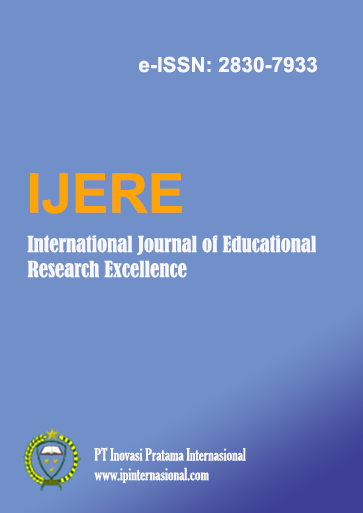Technology Innovations in Education: Their Effects on Student Motivation and Learning Achievement
Main Article Content
Abstract
The following article discusses the impact of technological innovation in education on students' motivation and learning achievement. This quantitative case study employed qualitative research methods to collect data through in-depth interviews, direct observation, and document analysis on a sample of secondary school students.The results indicate that the integration of technology, such as digital-based learning applications, learning management systems (LMS), and interactive tools, fosters increased student motivation through learning experiences that are more engaging and interactive. The study also identified significant challenges in the implementation of technology and provided recommendations to facilitate more effective integration.
Downloads
Article Details

This work is licensed under a Creative Commons Attribution 4.0 International License.
References
Abdussamad, Z. (2022). Buku Metode Penelitian Kualitatif. https://doi.org/10.31219/osf.io/juwxn
Anita A. Cahyanti, Malikatul Laila, & Agus Wijayanto. (2024). Motivation Profiles in L2: Exploring the Interplay of Intrinsic and Extrinsic Motivation: A Case Study of Senior Islamic High School in PPMIA Surakarta. JPGENUS: Jurnal Pendidikan Generasi Nusantara, 2(2), 270–281. https://doi.org/10.61787/w957cz32
Aris Sabthazi, Eva Farihah Megawaty, Moch Rahman Saleh, & Efrita Norman. (2024). Analysis of the Influence of Intrinsic and Extrinsic Factors on Teachers’ Work Motivation in Improving Educational Performance in Elementary Schools. MES Management Journal, 3(3). https://doi.org/10.56709/mesman.v3i3.554
Asdi Durahim, Abd. Rahman Pakaya, & Meyko Panigoro. (2024). The effect of motivation, learning discipline, and family environment on the learning achievement of students in public high school 1 tapa. International Journal of Science and Research Archive, 12(2), 142–152. https://doi.org/10.30574/ijsra.2024.12.2.1194
Darmansyah, D., Sakinah, S., Suparto, S., & Medopa, N. (2023). Implementation of Problem-Based Learning Strategies in instilling Disciplined Attitudes of Students in Class V of Ogotulo Small Remote Elementary School, Sidoan District Parigi Moutong Regency. The Journal of Inventions Pedagogical and Practices, 2(2), 93–98. https://doi.org/10.58977/jipp.v2i2.42
Dobosh, N. (2024). EDUCATION AND ECONOMY IN THE DIGITAL AGE (A. Ostenda (ed.)). Wydawnictwo Wyższej Szkoły Technicznej w Katowicach. https://doi.org/10.54264/M038
Li, H., Liu, H., & Chang, W.-Y. (2024). Extrinsic Motivation vs. Intrinsic Motivation: Key Factors Influencing Farmers’ Land Quality Protection Behavior in China. Environmental Management. https://doi.org/10.1007/s00267-024-02088-9
Meepung, T., Pratsri, S., & Nilsook, P. (2021). Interactive Tool in Digital Learning Ecosystem for Adaptive Online Learning Performance. Higher Education Studies, 11(3), 70. https://doi.org/10.5539/hes.v11n3p70
Monib, W. K., Qazi, A., & Mahmud, M. M. (2024). Exploring learners’ experiences and perceptions of ChatGPT as a learning tool in higher education. Education and Information Technologies. https://doi.org/10.1007/s10639-024-13065-4
Permana, G. P. L., & Martatika, K. A. W. (2024). Potential and challenges of blockchain technology implementation in Higher Education: A systematic literature review. Review of Management, Accounting, and Business Studies, 5(1), 57–67. https://doi.org/10.38043/revenue.v5i1.5580
Rana, C., Ye, J., Lam, M., & Daware, A. (2024). Transforming STEM Education with Design Thinking. ASCILITE Publications, 67–68. https://doi.org/10.14742/apubs.2024.1430
Rochmawati, D., Nurkamto, J., Nizam, M., Rochsantiningsih, D., & Sunardi, S. (2024). A Systematic Review of Self-Regulated Learning Approach through Digital Learning Media in Enhancing Students’ EFL Speaking Competences. English Education Journal, 14(4), 779–794. https://doi.org/10.24815/eej.v14i4.37800
Sutama, Yusrina, H., Narimo, S., Harsono, Novitasari, M., & Adnan, M. (2024). Mathematics Learning Model Based on Computational Thinking: Preparing elementary School Students to be Disciplined, Independent, and Dignified. Journal of Law and Sustainable Development, 12(1). https://doi.org/10.55908/sdgs.v12i1.3086
Wang, Z., & Na, H. (2023). Multimedia Technology Based Interactive Translation Learning for Students. ACM Transactions on Asian and Low-Resource Language Information Processing. https://doi.org/10.1145/3588569
Zhang, J. (2023). The Relationship Between Effects of Extrinsic Motivation and Intrinsic Motivation in Children’s Educational Development. Lecture Notes in Education Psychology and Public Media, 22(1), 335–340. https://doi.org/10.54254/2753-7048/22/20230335
Zolotarova, S., Ponomarova, M., Stankevych, S., Novikova, V., & Zolotarov, A. (2024). Integration of the educational process in higher education with digital technologies. Naukovyi Visnyk Natsionalnoho Hirnychoho Universytetu, 3, 149–156. https://doi.org/10.33271/nvngu/2024-3/149

